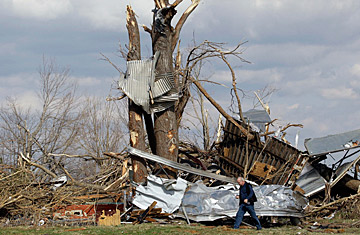
A volunteer looks around debris after a tornado struck in Marysville, Ind., Saturday, March 3, 2012.
(2 of 2)
I follow the governor's contingent around the northeast side of the school as he heads for his chopper on the high school track. The gym's roof and outer wall are missing. The hoops are intact. I break off around the side of the school, toward the southwest side that was the first point of contact with the twister.
A teacher goes in and out of a hole in the wall, furtively retrieving items from her classroom. She declines to give her name because she knows she shouldn't be here. Soon, a trooper shoos her away. Her father, unbidden, tells me the real heroes are the elementary and high school principals who cut the students loose at 2:35 p.m., 15 minutes earlier than usual and about 40 minutes before the storm hit. My cousin's wife, Beth, has another take. Everything in Louisville pretty much closed up shop around 1 p.m. — universities included — and she thinks her school waited way too long. She's livid about it.
Just beyond the high school, the hillside is strewn with the debris of what used to be four homes. In the first, a two-bedroom house with no basement, six people huddled in a bedroom and survived as the house was blown 150 feet off its foundation.
The next house is Thoms'. A two-car garage under the house remains and that's it. Thoms was at work: she teaches school in Scott County, one county north. At the next house, an Indiana State Police car has been crushed by a tree, its windows shattered and passenger door open. I run into Shaun Hannon, a state trooper who tells me his friend, Trooper Martin Wimp, who lives there, had just gotten home when the storm hit. As Wimp went to the basement, the bungalow was blown off its foundation and disintegrated. Wimp was trapped under a stairwell and a room air conditioner. His house was completely blown apart.
Hannon and Wimp had just worked out in Clarksville, then had lunch. When he couldn't reach Wimp, Hannon drove to the house, which he recognized only from the shrubs in front. He expected to find his friend dead in the field and was more than relieved to learn he'd been taken to the hospital with serious but non-life-threatening injuries.
Wimp's wife Elizabeth, in coveralls, is working with the guys and doesn't have much to say. She is grateful that her husband was spared and thankful for all the friends who've come to pull the piles apart. She teaches at the same school as Thoms, her aunt. The school was locked down.
Noting that Wimp survived a serious bull-riding accident in his youth, which led to a metal plate in his leg and which kept him out of the Marines until he insisted doctors remove it, after which he was a sniper in Iraq, his stepfather, Danny Berry, wonders how many lives he has. Danny's looking around for important things, like birth records or photographs. So far, it's slow going. He tells me one of Martin's trooper ID cards has been found 60 miles past Cincinnati in Ohio.
Friday afternoon, it was 75 degrees. Saturday, it is freezing cold and the wind won't stop. The Sunday forecast calls for snow.
F4 twisters don't happen in Indiana. But the Gulf of Mexico is overheated. The Weather Channel's Jim Cantore, who is on scene, is stunned that this could happen in March — it's the month's worst outbreak ever, he tells me, and adds that it portends a rough twister season.
I almost got run over by a state trooper on Pine Drive, who never saw me as he backed out of a driveway. I was lost in thought, wondering how to reconcile self-interested relief with survivor's guilt or perhaps thinking how it must feel to see the school you've attended for 11 years — your school, the central organizing feature in your small town — become wrecking ball fodder.
